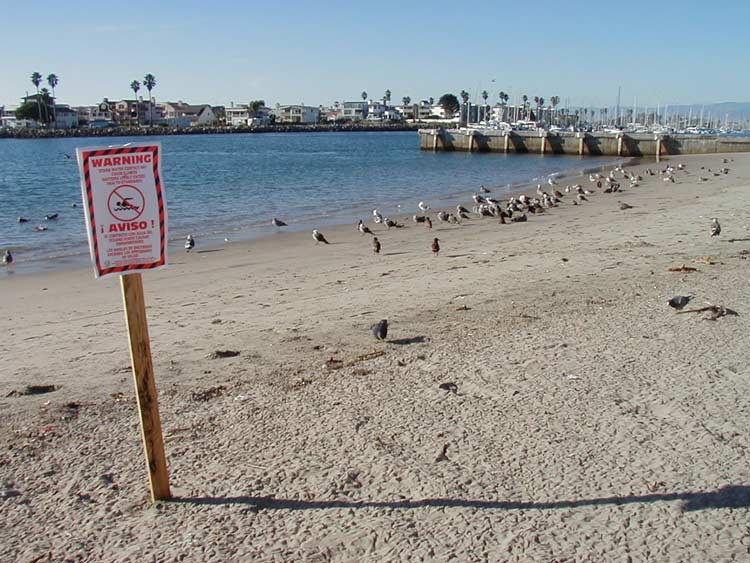|
December 19, 2014
Stanford study shows ways to improve public health at beaches
Thanks to new Stanford research, an affordable, easy-to-implement system can provide significantly more accurate information on coastal water contamination to better protect public health. By Rob Jordan

Sign warning of contamination at Channel Islands Harbor, Ventura, Calif. New models could help public health officials better predict when water contaminants will harm beach goers. (Photo: Cara Smith / Heal the Bay)
A new Stanford study shows how to improve the public health at beaches where coastal contamination can be a problem.
The analysis by researchers from Stanford; the University of California, Los Angeles; and the nonprofit environmental group Heal the Bay shows that relatively easy-to-use predictive modeling systems offer an improvement over current monitoring methods.
If implemented, these predictions could give beachgoers a better chance to avoid waterborne ailments such as gastroenteritis, respiratory illness, skin rashes and ear, nose and throat infections.
Getting gastroenteritis – the "stomach flu," which often comes with diarrhea, vomiting and fever – is one of several ailments that can affect people infected by water polluted with fecal bacteria from sewage.
Alexandria Boehm, the Clare Booth Luce Associate Professor of Structural Engineering at Stanford, was a co-author of the research report. "The current approach warns the public of the potential health risks of swimming at polluted beaches based on yesterday's news," she said.
Co-author Amanda Griesbach, a beach water quality scientist with Heal the Bay, noted, "We wanted to find a way to better protect the public health of the more than 150 million people who visit California beaches every year."
Potential to improve monitoring
Currently, for financial and logistical reasons, most beach managers analyze swimming waters only once a week. These tests, which involve analyzing water samples for fecal indicator bacteria, generally take 18 to 24 hours. The fastest sampling method available can take up to six hours. In the meantime, swimmers continue swimming and water conditions can change within a few hours, making lab results inaccurate.
"We know for sure that the method used now is not accurate," said Boehm, a senior fellow at the Stanford Woods Institute for the Environment.
By contrast, predictive models based on a range of site-specific data can return highly accurate water characterizations within about an hour.
To develop these models, Boehm and her colleagues worked with beach managers at 25 Southern California beaches to collect site-specific archival data such as rainfall amounts, tide levels and pollution concentrations.
"Once we are familiar with the data availability and beach characteristics, we will know what types of input variables are probably useful in water quality prediction, and thus we can develop the predictive models quite efficiently," said study lead author Wai "Anthony" Thoe, a postdoctoral scholar in civil and environmental engineering at Stanford.
Using publically available software, the researchers developed and tested more than 700 models. They used five different types of statistical models for each beach, and determined which type of model could best predict beach advisories.
Beach management
In the future, beach managers may be able to run models, specifically tailored to their beaches' characteristics, by simply entering data into an Excel spreadsheet, said Thoe.
Thoe worked on a similar modeling project for beaches in Hong Kong. Dubbed Project WATERMAN, it resulted in a range of web tools and apps anyone can download to monitor water quality at any time.
"We believe with these apps and web pages, the public can feel more engaged and can easily access prediction results that may help them determine whether they want to swim at a particular beach on that day," Thoe said.
Although Thoe has yet to create apps for the United States, the study's second phase this summer will likely include a public notification component. The researchers plan to work with managers at three Southern California beaches – Doheny State Beach, Santa Monica State Beach and Arroyo Burro Beach Park – to better understand the nonscientific obstacles to implementation of predictive models for issuing beach advisories.
Along the way, they will further refine their models by, for example, adding data on factors such as salinity and or water cloudiness.
Better monitoring
The U.S. Environmental Protection Agency has recommended the use of predictive models to manage beaches. However, states, which have jurisdiction over beach management, have not rushed to embrace the approach. In the United States, the approach is used only at a few beaches along the Great Lakes. This may be because until now there has been no large proof-of-concept-type study on predictive modeling.
It may also be because there is little federal or state legal guidance on using predictive models. California's Assembly Bill 411, for example, exhaustively covers recreational water quality sampling, but says nothing about predictive models, according to Boehm.
Boehm said she hopes the study – the first systematic assessment of predictive modeling on a range of beaches with varying geographic and pollution characteristics – is an important step toward adoption.
"Soon, we'll be able to use beach water quality models like the weather report," said co-author Mark Gold, acting director of the UCLA Institute of the Environment and Sustainability. "Swimmers and surfers will be able to know about water quality before they go to their favorite beach."
This study was funded by the California State Water Resources Control Board.
-30-
|